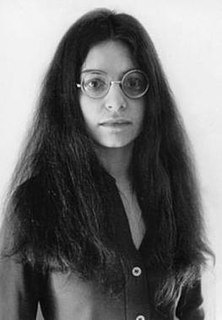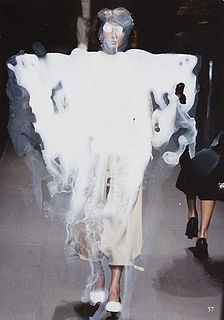Related Research Articles

Shulamith Bath Shmuel Ben Ari Firestone was a Canadian-American radical feminist writer and activist. Firestone was a central figure in the early development of radical feminism and second-wave feminism and a founding member of three radical-feminist groups: New York Radical Women, Redstockings, and New York Radical Feminists. Within these radical movements, Firestone became known as "the firebrand" and "the fireball" for the fervor and passion she expressed towards the cause. Firestone participated in activism such as speaking out at The National Conference for New Politics in Chicago. Also while a member of various feminist groups she participated in actions including picketing a Miss America Contest, organizing a funeral for womanhood known as "The Burial of Traditional Womanhood", protesting sexual harassment at Madison Square Garden, organizing abortion speak outs, and disrupting abortion legislation meetings.
Cyberfeminism is a feminist approach which foregrounds the relationship between cyberspace, the Internet, and technology. It can be used to refer to a philosophy, methodology or community. The term was coined in the early 1990s to describe the work of feminists interested in theorizing, critiquing, exploring and re-making the Internet, cyberspace and new-media technologies in general. The foundational catalyst for the formation of cyberfeminist thought is attributed to Donna Haraway's "A Cyborg Manifesto", third wave feminism, post-structuralist feminism, riot grrrl culture and the feminist critique of the alleged erasure of women within discussions of technology.
Faith Wilding is a Paraguayan American multidisciplinary artist - which includes but is not limited to: watercolor, performance art, writing, crocheting, knitting, weaving, and digital art. She is also an author, educator, and activist widely known for her contribution to the progressive development of feminist art. She also fights for ecofeminism, genetics, cyberfeminism, and reproductive rights. Wilding is Professor Emerita of performance art at the School of the Art Institute of Chicago.

Feminist art is a category of art associated with the late 1960s and 1970s feminist movement. Feminist art highlights the societal and political differences women experience within their lives. The hopeful gain from this form of art is to bring a positive and understanding change to the world, in hope to lead to equality or liberation. Media used range from traditional art forms such as painting to more unorthodox methods such as performance art, conceptual art, body art, craftivism, video, film, and fiber art. Feminist art has served as an innovative driving force towards expanding the definition of art through the incorporation of new media and a new perspective.
Melinda Rackham is an Australian artist, writer and curator.
The Australian Network for Art and Technology (ANAT), was founded by the Australian Experimental Art Foundation in 1988. ANAT is a nonprofit organization that provides tools to assist Australian artists, particularly those in media arts. Its programming includes workshops, publications, and immersive residencies.
VNS Matrix was an artist collective founded in Adelaide, Australia, in 1991, by Josephine Starrs, Julianne Pierce, Francesca da Rimini and Virginia Barratt. Their work included installations, events, and posters distributed through the Internet, magazines, and billboards. Taking their point of departure in a sexualised and socially provocative relationship between women and technology the works subversively questioned discourses of domination and control in the expanding cyber space. They are credited as being amongst the first artists to use the term cyberfeminism to describe their practice.

Cornelia Sollfrank is a German digital artist, she was an early pioneer of Net Art and Cyberfeminism in the 1990s.
Hugh Davies, is an Australian media arts practitioner, researcher and educator.
Australian feminist art timeline lists exhibitions, artists, artworks and milestones that have contributed to discussion and development of feminist art in Australia. The timeline focuses on the impact of feminism on Australian contemporary art. It was initiated by Daine Singer for The View From Here: 19 Perspectives on Feminism, an exhibition and publishing project held at West Space as part of the 2010 Next Wave Festival.
Amanda McDonald Crowley is a New York-based Australian curator and arts administrator who has created exhibitions and events focused on new media art, contemporary art, and transdisciplinary work. She has served as the executive director of Eyebeam Art + Technology Center in New York City and as the artistic director at the Bemis Center for Contemporary Arts in Omaha, Nebraska.
subRosa is a cyberfeminist organization led by artists Faith Wilding and Hyla Willis.
Linda Dement is an Australian multidisciplinary artist, working in the fields of digital arts, photography, film, and writing non-fiction. Dement is largely known for her exploration of the creative possibilities of emergent technologies such as the CD-ROM, 3-D modelling, interactive software, and early computing.
Nancy Evelyn Paterson (1957–2018) was a Canadian artist and writer known for her work in new media. She was an associate professor at the Ontario College of Art and Design University from 1990 to 2018, and was Facilities Coordinator at Charles Street Video, a non-profit, artist-run centre providing production and post-production facilities for digital video and audio.
Virginia Barratt is an Australian researcher, artist, writer and performer. She is currently writing a PhD at Western Sydney University in the Writing and Society Centre. Barratt's doctoral research focuses on panic, affect and deterritorialization, explored through performance, experimental poetics and vocalities.
Josephine Starrs is an Australian artist who creates socially engaged art focusing on human relationships to new technologies, nature and climate change. Her video and new media work has been exhibited in Australia and at international art exhibitions. She was a Senior Lecturer in Media Arts at Sydney College of the Arts, University of Sydney until 2016.
Prema Murthy is an American, multi-disciplinary artist based in New York. Employing aesthetics, gesture, geometry and algorithmic processes, Murthy's work explores the boundaries between embodiment and abstraction, while engaging in issues of culture and politics. Her work has been exhibited nationally and internationally at MoMA PS1, the Whitney Museum of American Art, the New Museum of Contemporary Art, the Reina Sofia Museum, the Generali Foundation in Vienna, and the India Habitat Center-New Delhi.
The Old Boys Network was the first international Cyberfeminist alliance. It was founded in 1997 in Berlin and remained active until 2001.
Francesca da Rimini is an artist and cyberfeminist. With Josephine Starrs, Julianne Pierce, and Virginia Barratt she co-founded VNS Matrix. She has been working in new media since 1984.
Margaret Dodd is an Australian artist who works in ceramics and film/video. Her most well-known work is a series titled I am not a Car that included ceramic models of Australian cars as well as an animated film, first shown at the Art Gallery of South Australia in 1977, and again in 2020.
References
- ↑ Judy Malloy (2003). Women, Art, and Technology. MIT Press. ISBN 978-0-262-13424-8.
- ↑ "old boys network 01". www.obn.org. Old Boys Network. Retrieved 29 November 2019.
- 1 2 "Julianne Pierce : Australian Dance Theatre". adt.org.au. Archived from the original on 1 May 2013. Retrieved 2 February 2014.
- 1 2 3 4 5 "T_P_S Curators". performancespace.com.au. Archived from the original on 18 February 2014. Retrieved 2 February 2014.
- ↑ Susan Hawthorne; Renate Klein (1999). Cyberfeminism: Connectivity, Critique and Creativity. Spinifex Press. ISBN 978-1-875559-68-8.
- ↑ Maria Fernandez; Faith Wilding (2002). "Situating Cyberfeminisms" (PDF). Domain Errors: Cyberfeminist practices: 17–28. Retrieved 2 February 2014.